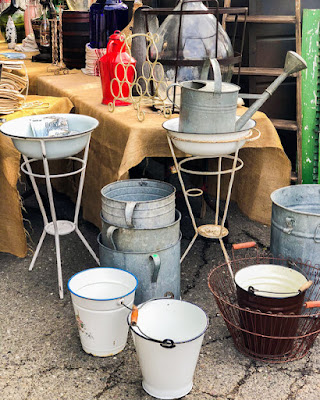
Popular event to be held in arena parking lot Sunday

|
|
Shoppers can find all kinds of fun containers,
tools and other items for the garden at the relocated Sac Antique Faire. (Photo courtesy Sacramento Antique Faire) |
It’s in a new location and, this month, a different day, but the Sacramento Antique Faire has long been a wonderful place for finding potential garden art, planting containers, used tools and decorations.
Packed with (mostly old) treasures of all kinds, the Sac Antique Faire will fill the parking lot of the old Sleep Train Arena from 6:30 a.m. to 3 p.m Sunday, Oct. 17. Admission is $3 (cash only); youth under age 16 admitted free. Parking is free.
The event uses the arena’s East Entrance parking booths as its admission gates. Enter using the Truxel Road gate.
“Admission is paid from your vehicle through a toll booth when arriving at the Faire,” says its website. Cash only keeps the cars moving.
Although this is an outdoor event, patrons are encouraged to wear face masks and social distance when possible.
For decades, the Faire was held under the “W-X Freeway,” that section of Interstate 80/50 that runs through Downtown and Midtown Sacramento. But construction work on that freeway forced the relocation of the monthly antiques market as well as the popular Sunday farmers market.
This fall, the Faire has made itself at home at the arena. The parking lots have plenty of room for more than 300 vendors plus many shoppers.
“All items must be antiques and/or collectibles,” according to the organizers. “The collectibles must be 20 years old or older. We do not sell crafted or newly manufactured goods at our Faire.”
That said, wear comfortable walking shoes; there will be a lot to browse!
Usually, the Faire is held on the second Sunday of each month; October’s event is an exception. The Faire will return to its usual day in November. Remaining 2021 dates are Nov. 14 and Dec. 12.
Those dates also will be held at Sleep Train Arena, 1 Sports Parkway, Sacramento.
Details and directions: www.sacantiquefaire.com .
Comments
0 comments have been posted.Sacramento Digs Gardening to your inbox.
Sites We Like
Garden Checklist for week of July 21
Your garden needs you!
* Keep your vegetable garden watered, mulched and weeded. Water before 8 a.m. to reduce the chance of fungal infection and to conserve moisture.
* Feed vegetable plants bone meal, rock phosphate or other fertilizers high in phosphate to stimulate more blooms and fruiting. (But wait until daily high temperatures drop out of the 100s.)
* Don’t let tomatoes wilt or dry out completely. Give tomatoes a deep watering two to three times a week.
* Harvest vegetables promptly to encourage plants to produce more. Squash especially tends to grow rapidly in hot weather. Keep an eye on zucchini.
* Pinch back chrysanthemums for bushy plants and more flowers in September.
* Remove spent flowers from roses, daylilies and other bloomers as they finish flowering.
* Pinch off blooms from basil so the plant will grow more leaves.
* Cut back lavender after flowering to promote a second bloom.
* It's not too late to add a splash of color. Plant petunias, snapdragons, zinnias and marigolds.
* From seed, plant corn, pumpkins, radishes, winter squash and sunflowers.